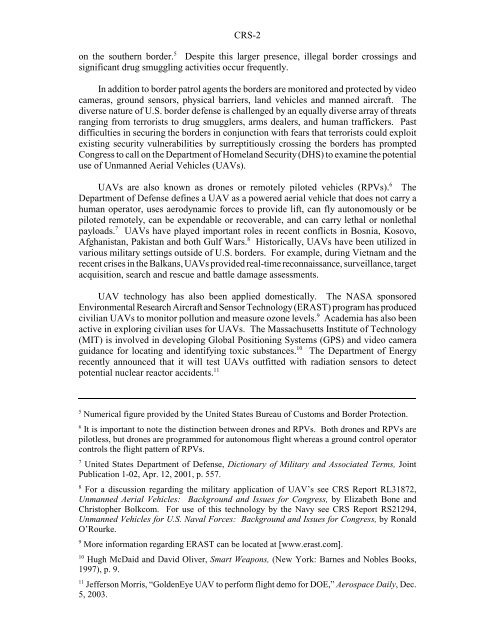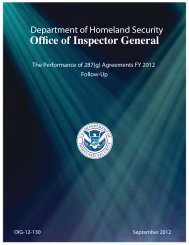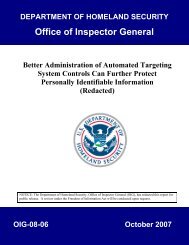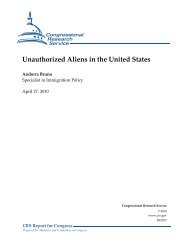Border Security and Unmanned Aerial Vehicles
Border Security and Unmanned Aerial Vehicles
Border Security and Unmanned Aerial Vehicles
Create successful ePaper yourself
Turn your PDF publications into a flip-book with our unique Google optimized e-Paper software.
CRS-2on the southern border. 5 Despite this larger presence, illegal border crossings <strong>and</strong>significant drug smuggling activities occur frequently.In addition to border patrol agents the borders are monitored <strong>and</strong> protected by videocameras, ground sensors, physical barriers, l<strong>and</strong> vehicles <strong>and</strong> manned aircraft. Thediverse nature of U.S. border defense is challenged by an equally diverse array of threatsranging from terrorists to drug smugglers, arms dealers, <strong>and</strong> human traffickers. Pastdifficulties in securing the borders in conjunction with fears that terrorists could exploitexisting security vulnerabilities by surreptitiously crossing the borders has promptedCongress to call on the Department of Homel<strong>and</strong> <strong>Security</strong> (DHS) to examine the potentialuse of <strong>Unmanned</strong> <strong>Aerial</strong> <strong>Vehicles</strong> (UAVs).UAVs are also known as drones or remotely piloted vehicles (RPVs). 6 TheDepartment of Defense defines a UAV as a powered aerial vehicle that does not carry ahuman operator, uses aerodynamic forces to provide lift, can fly autonomously or bepiloted remotely, can be expendable or recoverable, <strong>and</strong> can carry lethal or nonlethalpayloads. 7 UAVs have played important roles in recent conflicts in Bosnia, Kosovo,Afghanistan, Pakistan <strong>and</strong> both Gulf Wars. 8 Historically, UAVs have been utilized invarious military settings outside of U.S. borders. For example, during Vietnam <strong>and</strong> therecent crises in the Balkans, UAVs provided real-time reconnaissance, surveillance, targetacquisition, search <strong>and</strong> rescue <strong>and</strong> battle damage assessments.UAV technology has also been applied domestically. The NASA sponsoredEnvironmental Research Aircraft <strong>and</strong> Sensor Technology (ERAST) program has producedcivilian UAVs to monitor pollution <strong>and</strong> measure ozone levels. 9 Academia has also beenactive in exploring civilian uses for UAVs. The Massachusetts Institute of Technology(MIT) is involved in developing Global Positioning Systems (GPS) <strong>and</strong> video cameraguidance for locating <strong>and</strong> identifying toxic substances. 10 The Department of Energyrecently announced that it will test UAVs outfitted with radiation sensors to detectpotential nuclear reactor accidents. 115Numerical figure provided by the United States Bureau of Customs <strong>and</strong> <strong>Border</strong> Protection.6It is important to note the distinction between drones <strong>and</strong> RPVs. Both drones <strong>and</strong> RPVs arepilotless, but drones are programmed for autonomous flight whereas a ground control operatorcontrols the flight pattern of RPVs.7United States Department of Defense, Dictionary of Military <strong>and</strong> Associated Terms, JointPublication 1-02, Apr. 12, 2001, p. 557.8For a discussion regarding the military application of UAV’s see CRS Report RL31872,<strong>Unmanned</strong> <strong>Aerial</strong> <strong>Vehicles</strong>: Background <strong>and</strong> Issues for Congress, by Elizabeth Bone <strong>and</strong>Christopher Bolkcom. For use of this technology by the Navy see CRS Report RS21294,<strong>Unmanned</strong> <strong>Vehicles</strong> for U.S. Naval Forces: Background <strong>and</strong> Issues for Congress, by RonaldO’Rourke.9More information regarding ERAST can be located at [www.erast.com].10Hugh McDaid <strong>and</strong> David Oliver, Smart Weapons, (New York: Barnes <strong>and</strong> Nobles Books,1997), p. 9.11Jefferson Morris, “GoldenEye UAV to perform flight demo for DOE,” Aerospace Daily, Dec.5, 2003.












